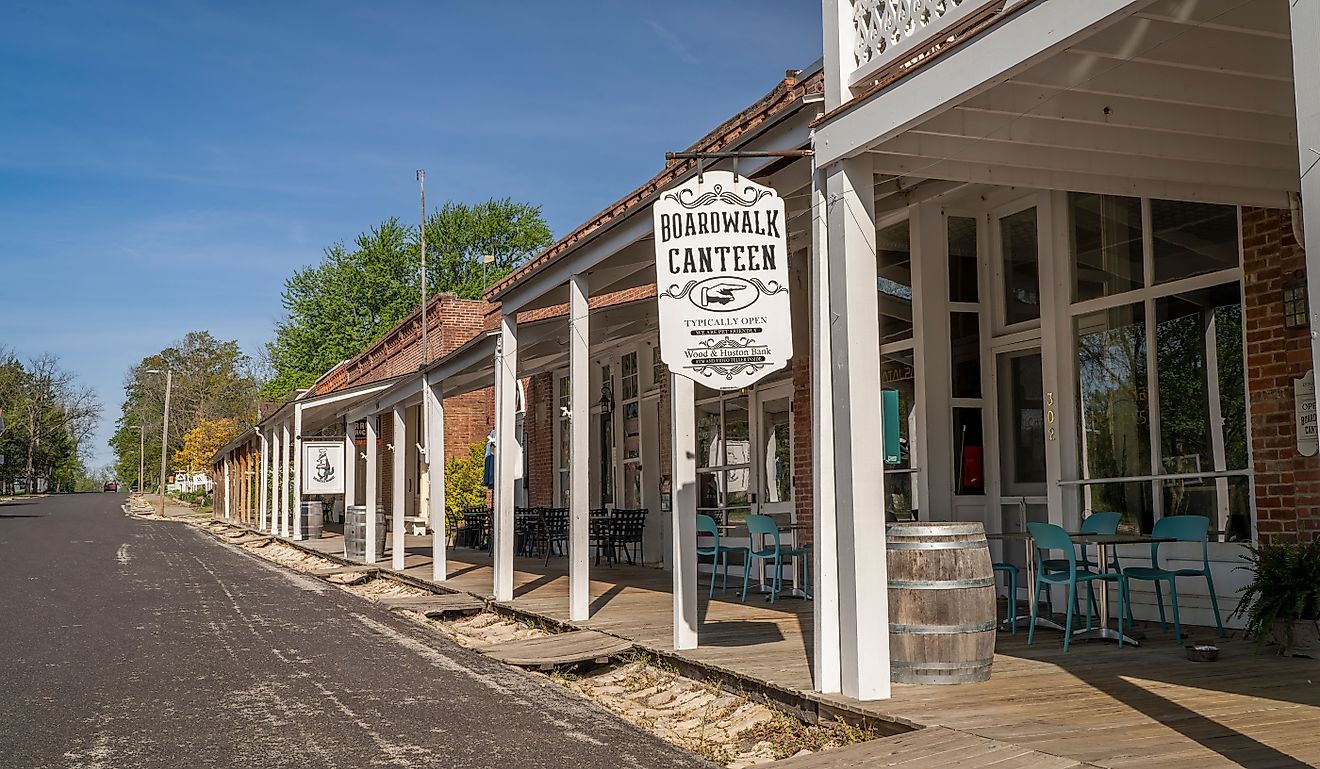
9 Best Downtowns In Texas
While Texas is commonly celebrated for its western ranches, towering skyscrapers, and boisterous sports culture, its true spirit lives in its downtowns. Here, these areas serve not just as mere geographical centers but as the lifeblood of community spirit and architectural charm.
From the Hill Country’s artistic enclaves to the historic squares of East Texas, these downtowns invite visitors to experience a different side of the Lone Star State. Far from the shadow of urban giants like Dallas and Houston, these towns offer a slice of Texan life that is as rich in heritage as it is in tranquility. If you're intrigued by the idea of exploring the unique, the historic, and the downright charming, then prepare to meet the towns that house the nine best downtowns in Texas!
Waxahachie

Waxahachie, located just south of Dallas, is renowned for its Ellis County Courthouse, a stunning example of Richardsonian Romanesque architecture. This town is also famous for hosting the annual Scarborough Renaissance Festival, which attracts visitors from across the state. The Webb Gallery, situated on West Franklin Street, showcases an eclectic mix of folk art and outsider art, making it a notable cultural landmark.

In terms of dining, the College Street Pub on West College Street offers a robust selection of British pub fare and craft beers in a cozy, brick-lined setting. For those seeking a quieter atmosphere, the White Rhino Coffee on South Rogers Street provides a relaxed environment with expertly crafted coffee and pastries. Additionally, Getzendaner Memorial Park offers trails and scenic spots ideal for picnics and leisurely walks.
Georgetown

Georgetown is home to stunning Victorian architecture and the historic Williamson County Courthouse at its center. The town square, often cited as the "Most Beautiful Town Square in Texas," is a focal point for community and cultural activities, including frequent arts and crafts festivals.
Visitors can explore the Georgetown Art Center, which hosts regional art exhibitions and workshops, located on Main Street. For dining, Monument Cafe offers a menu of classic American dishes made from locally sourced ingredients, reflecting the area’s commitment to community-supported agriculture. Coffee lovers can head to 309 Coffee on East Street for a selection of meticulously crafted beverages in a modern, welcoming space. Blue Hole Park, a scenic lagoon on the San Gabriel River, provides a picturesque setting for outdoor relaxation and activities just north of the downtown area.
Boerne

Boerne, in the Texas Hill Country, blends German heritage and Texan hospitality. This heritage is prominently reflected in the Hill Country Mile, a stretch of locally owned boutiques, restaurants, and galleries that line South Main Street, providing a unique shopping and dining experience.
Among the notable establishments, The Dienger Trading Co. offers a boutique shopping experience coupled with a bistro that serves gourmet sandwiches and coffee in a restored 19th-century building. Cypress Grille, another highlight on Main Street, specializes in fine dining with a menu that features creative takes on American cuisine. For cultural enthusiasts, the Boerne Community Theatre presents a variety of plays and musicals that draw talent from across the region. Cibolo Nature Center, just outside the downtown area, offers trails and natural exhibits, promoting conservation and education about the local ecosystem.
Grapevine

Grapevine plays a huge role as a center of the Texas wine industry. The town’s historic Main Street is lined with beautifully restored 19th-century buildings, hosting numerous wineries and the Grapevine Vintage Railroad, which offers a nostalgic ride on a 1920s-era train.
Visitors can enjoy farm-to-table dishes at Harvest Hall, a food hall featuring seven artisanal kitchens. Esparza’s Restaurante Mexicano, set in a historic home on East Worth Street, is renowned for its Tex-Mex cuisine and margaritas. The Grapevine Historical Museum, housed in the historic Donald Schoolhouse, provides insights into the area’s past. Moreover, the nearby Grapevine Lake offers hiking, biking, and picnic areas. Each year, the town also hosts GrapeFest, a large wine festival that celebrates local and international wines.
Nacogdoches

Nacogdoches, recognized as the oldest town in Texas, flaunts a deep historical heritage evident in its gorgeous downtown area. The Nacogdoches Historic District features landmarks such as the Sterne-Hoya House Museum and Library, which offers a glimpse into 19th-century life in Texas. This town is also home to Stephen F. Austin State University, adding a vibrant academic atmosphere to the community.
Downtown Nacogdoches invites visitors to explore local flavors and crafts at the Farmer's Market on Pearl Street, where regional produce and artisan goods are available. For dining, Dolli's Diner on East Main Street provides classic American meals in a retro setting. The Liberty Bell is another key attraction, a bar and restaurant offering live music and a selection of craft beers and wines. Pilar Street Park, with its quaint walking paths and historic sites, offers a peaceful retreat right in the heart of town.
Fredericksburg

Fredericksburg, located in central Texas, is distinguished by its German heritage, which is evident in the town's architecture and annual festivities such as Oktoberfest. Main Street, the heart of Fredericksburg, is lined with over 150 shops, restaurants, and galleries, all within blocks of the historic Nimitz Hotel now housing the National Museum of the Pacific War, a comprehensive museum dedicated to the Pacific Theatre of WWII.
Visitors can dine at Otto's German Bistro, which offers an innovative twist on traditional German cuisine, focusing on local ingredients and fine wines. Across the street, the Fredericksburg Pie Company serves a variety of homemade pies in a cozy, welcoming setting. Art enthusiasts will enjoy the many galleries, including RS Hanna Gallery, which showcases contemporary artists with a focus on traditional and impressionistic works. For outdoor leisure, Marktplatz, located in the center of downtown, provides a picturesque park setting complete with walking paths, a playground, and a pavilion.
Granbury

Granbury lies southwest of Fort Worth and is celebrated for its 19th-century Granbury Square, anchored by the iconic Hood County Courthouse, a historic limestone structure built in 1890. The town's dedication to maintaining its historical character and charm is evident in the numerous buildings that have been restored to their original state.
Visitors can enjoy a variety of dining and shopping experiences around the square. Christina's Bistro on the Square offers a selection of gourmet sandwiches and soups, ideal for a casual lunch. Just off the square, D'Vine Wine provides wine tastings and bottles of local Texan wines. The Granbury Opera House, dating back to the 1880s, hosts regular performances, adding a cultural flair to the area. For those interested in outdoor activities, the nearby City Beach Park offers a sand beach and boardwalk, perfect for family outings or a relaxing stroll.
Bastrop

Bastrop, situated southeast of Austin along the Colorado River, is enveloped by the "Lost Pines," an isolated stand of loblolly pines. The town's rich history is preserved in its charming downtown, which features a blend of historic buildings and modern boutiques, embodying a small-town atmosphere with a distinctive Texan flair.
Main Street in downtown Bastrop is the hub of activity, housing unique establishments like the Colorado River Winery, where visitors can taste local wines in a cozy setting. Neighbor's Kitchen and Yard, located right on the riverbank, offers live music and classic pizza, creating a lively dining experience. For culture enthusiasts, the Bastrop Opera House presents a range of theatrical productions throughout the year. Fisherman's Park provides outdoor recreation opportunities with access to the river, picnic areas, and sports facilities.
Salado

Known for its artistic community and historical sites, Salado attracts visitors with its blend of creative shops and iconic architecture. The town is also famous for the Salado Creek, a significant waterway that has supported human habitation for thousands of years, adding a natural charm to its downtown area.
Main Street is the core of Salado's downtown, lined with unique boutiques such as Magnolia’s Boutique, which features custom jewelry and fashionable attire, and the Salado Glassworks, where visitors can watch glassblowing and purchase handmade glass items. For dining, The Stagecoach Inn offers classic Texas fare in one of the oldest hotels in the state. Just a short walk away, Barrow Brewing Company provides locally crafted beers in a friendly, rustic setting. Pace Park, alongside Salado Creek, offers a scenic spot for picnicking and relaxing.
In conclusion, this exploration into the downtowns of nine small Texan towns highlights their crucial role as cultural and historical nexuses, distinct from the state's urban centers. These areas, characterized by their preservation of tradition and vibrant community life, offer a microcosm of Texas's rich cultural landscape. Through a detailed examination of these downtowns, one gains a deeper understanding of Texas's heritage and the contemporary dynamics of its smaller communities. This investigation not only enriches our appreciation of Texas's diverse cultural fabric but also underscores the importance of these towns in maintaining the state's historical continuity and communal vitality.











